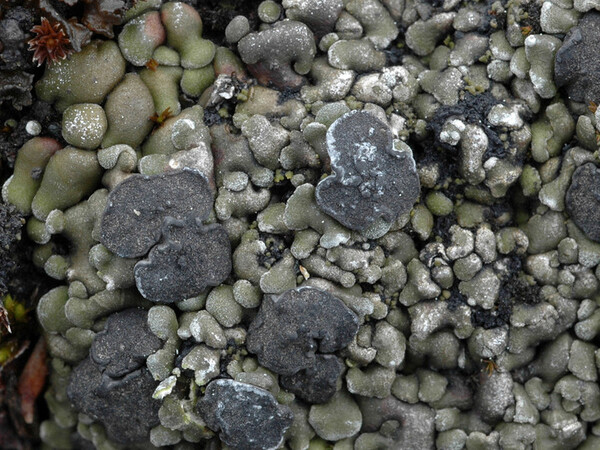Thalloidima squamatum (Hoffm.) M. Westb. & Timdal
in Westberg & al. , Plant and Fungal Systematics, 68, 2: 358, 2023. Basionym: Psora squamata Hoffm. - Deutschl. Fl., 2: 161, 1796 (1795)
Synonyms:
Distribution: N - Ven (Westberg & al. 2023).
Description: Thallus squamulose, often forming compact, up to 8 cm wide patches, the squamules up to 6 mm long, contiguous to sometimes imbricate, bullate from the beginning, rounded to finally irregularly lobed, sometimes columnar, the larger ones sometimes horizontally flattened. Upper surface pale brown, greenish brown or dark green, smooth, usually partly covered with a white, farinose pruina, but sometimes epruinose to densely white-pruinose, without pseudocyphellae; lower side pale brown to whitish. Upper cortex 20-40 μm thick, including an up to 15 μm thick epinecral layer, often containing or covered by crystals of calcium oxalate, of thick-walled, irregularly to mainly anticlinally arranged hyphae with rounded to elongated cells; medulla white to pale yellow, lacking crystals, consisting of a spongy tissue of thin-walled hyphae; algal layer continuous; lower cortex resembling the upper one, but thinner. Apothecia lecideine, at first rounded, then strongly irregular in outline, up to 4 mm across, black, epruinose or rarely entirely pruinose, finally immarginate. Proper exciple colourless to pale golden brown in outer part, darker golden brown within; epithecium grey, often with a faint violet tone, K+ purple, N+ purple; hymenium colourless, 65-80 μm high; paraphyses simple, stout, c. 3 μm thick at mid-level, the apical cells subcylindrical to clavate, up to 6 μm wide; hypothecium golden brown to red-brown. Asci 8-spored, narrowly clavate , surrounded by a gelatinous I+ blue coat, with a well-developed I+ blue tholus, a I+ darker blue tube and a well-developed ocular chamber, Bacidia-type. Ascospores 1-septate, hyaline, fusiform or with one end rounded, 12-20 x 3-4 μm. Photobiont chlorococcoid. Spot tests: cortex and medulla K-, C-, KC-, P-, UV-. Chemistry; thallus without lichen substances: epithecium with the Sedifolia-grey pigment. Note: a recently-described, apparently widespread species growing on moss cushions over calcareous rocks or directly on rock, rarely on soil. Italian material of Th. sedifolium should be checked against this species, which is likely to be quite common, especially in upland areas.
Growth form: Squamulose
Substrata: rocks, soil, terricolous mosses, and plant debris
Photobiont: green algae other than Trentepohlia
Reproductive strategy: mainly sexual
Commonnes-rarity: (info)
Alpine belt: very rare
Subalpine belt: rare
Oromediterranean belt: absent
Montane belt: rare
Submediterranean belt: very rare
Padanian area: absent
Humid submediterranean belt: very rare
Humid mediterranean belt: absent
Dry mediterranean belt: absent

Predictive model
Herbarium samples
Growth form: Squamulose
Substrata: rocks, soil, terricolous mosses, and plant debris
Photobiont: green algae other than Trentepohlia
Reproductive strategy: mainly sexual
Commonnes-rarity: (info)
Alpine belt: very rare
Subalpine belt: rare
Oromediterranean belt: absent
Montane belt: rare
Submediterranean belt: very rare
Padanian area: absent
Humid submediterranean belt: very rare
Humid mediterranean belt: absent
Dry mediterranean belt: absent

Predictive model
| Herbarium samples |





